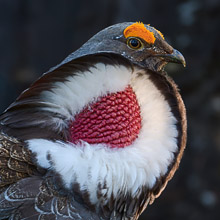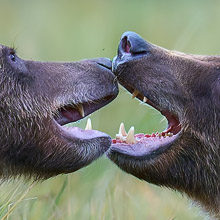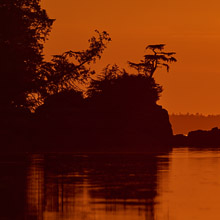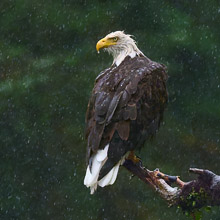Availability: Undetermined - Enquiries?
In the Field
Before the Fear - Coastal Gray Wolf Pup. Great Bear Rainforest, British Columbia, Canada. September 19, 2024.
I captured this image of a young coastal Gray Wolf during an extended shooting session during my "Into the Great Bear Rainforest" Exploratory Photo Adventure in the autumn of 2024. This pup was about 6 months old at the time I photographed it. Its lopsided and casual sitting position reminded me of the way one of my own Portuguese Water Dogs used to sit (which is part of the reason I shot this image). The other thing that kind of blew me away during this shooting session was how this pup's curiosity about us (we were just offshore floating in a Zodiac inflatable at the time) dominated over its fear of us. Keep in mind that the wolf family that this pup belongs to is in an area outside of any provincial or national park and that British Columbia's hunting regulations empower hunters to opportunistically annihilate wolves whenever they are encountered.
Because of a reasonably recent and recurrent pattern of successfully finding coastal Gray Wolves I have decided to run my first wolf-focused Great Bear Rainforest photo tour in the summer of 2026. Even with our recent success of finding cooperative wolves it is definitely still possible we'll get skunked on wolves on this photo tour. Fortunately if this does happen we'll have a lot of other good subject matter to work with, usually including a few flavors of bears, Humpback, Killer, and Fin Whales, Steller Sea Lions, Harbour Seals, Bald Eagles, and more.
I won't be accepting registrations for this new and exciting photo tour until later in 2025, but if you're interested in getting "first dibs" on one of the spots on this trip, feel free to sign up for the Priority Booking List for this trip. This list is simply a "first right of refusal list" and there is no commitment (i.e., no deposit) required to go on it. Details about how to add yourself to the Priority Booking List for the wolf trip can be found right here....
Here's a larger version (4800 pixel) of this casual and calm wolf pup:
• Before the Fear - Coastal Gray Wolf Pup: Download 4800 pixel image (JPEG: 5.2 MB)
ADDITIONAL NOTES:
1. These images - in all resolutions - are protected by copyright. I'm fine with personal uses of them (including use as desktop backgrounds or screensavers on your own computer), but unauthorized commercial use of the image is prohibited by law. Thanks in advance for respecting my copyright!
2. Like all photographs on this website, these images were captured following the strict ethical guidelines described in The Wildlife FIRST! Principles of Photographer Conduct. As such, no baiting or any form of attractant was used and, as always, we attempted to minimize our impact on the ongoing behaviour of the subjects. I strongly encourage all wildlife photographers to always put the welfare of their subjects above the value of their photographs.
3. This image was captured during my Into the Great Bear Rainforest Exploratory Photo Adventure in late September of 2024. Each year I offer trips into the Great Bear Rainforest as well as tours into the Khutzeymateen Grizzly Sanctuary (to photograph grizzlies, of course!). Details about these trips can be found on the Photo Tours page of this website.
Behind the Camera
Before the Fear - Coastal Gray Wolf Pup. Great Bear Rainforest, British Columbia, Canada. September 19, 2024.
High Efficiency* Compressed RAW (NEF) format; ISO 2500.
Nikon Z 9 paired with Z Nikkor 800mm f6.3S. Hand-held from a floating Zodiac inflatable boat. VR on in Sport mode. 3D-tracking AF area mode with subject detection on "Animal" mode.
1/640s @ f6.3; No compensation from matrix-metered exposure setting.
At the Computer
Before the Fear - Coastal Gray Wolf Pup. Great Bear Rainforest, British Columbia, Canada. September 19, 2024.
Initial noise reduction and capture sharpening on the .nef (raw) file using the DeepPRIME XD2S algorithm of DXO PhotoLab 8.1 Elite (using the appropriate lens/camera optical module).
Subsequent adjustments to the adjusted linear DNG file (exported from PhotoLab) and conversion to 16-bit TIFF file (and JPEG files for web use) - including all global and selective adjustments - made using Phase One's Capture One Pro (build 16.4.6). In the case of this image the only global adjustments were minor tweaks to contrast (a Levels adjustment) and the highlights. Selective local adjustments performed using Capture One Pro's layers and masking tools. In this case numerous small adjustments and minor tweaks were made on 7 separate layers, with the tweaks being associated with "exposure balancing" and contrast adjustments (such as adjustments to brightness, clarity, highlights, shadows, etc.).
Photoshop modifications included insertion of the watermark and/or text.
Conservation
Pausing to Reflect - Coastal Gray Wolf. Great Bear Rainforest, British Columbia, Canada. September 20, 2024.
Species Status in Canada*: Only Eastern Wolf listed as species of "Special Concern" in May, 2001. Other populations not listed as Endangered or Threatened.
Probably no species alive today has suffered as much direct persecution from humans as has the Gray Wolf (Canis lupus). Once extremely widespread in North America, the Gray Wolf was virtually extirpated from the contiguous 48 states of America and now is regularly found within only a fraction of its historical range in Canada. While the Gray Wolf is currently listed as endangered in most of the 48 lower states of the United States and enjoys the privileges associated with such status (if lack of persecution and abuse can be thought of as a privilege), it is still official policy in much of Canada to rid the countryside of this magnificent keystone predator. As an example, in British Columbia, there is NO closed season on the wolf in most hunting jurisdictions and opportunistic slaughter is encouraged by policy (it is the ONLY fur-bearing species for which NO species hunting tag is required in British Columbia!). Conservation of wolves presents a puzzling paradox. Reduced to the most basic principles, wolf conservation is simplistic: we need only to stop persecuting this species in order for it to survive. Yet accomplishing this invariably proves incredibly difficult - it's as though wolf persecution has been institutionalized directly into government (and societal) bureaucracy.
*as determined by COSEWIC: The Committee on the Status of Endangered Wildlife in Canada


























